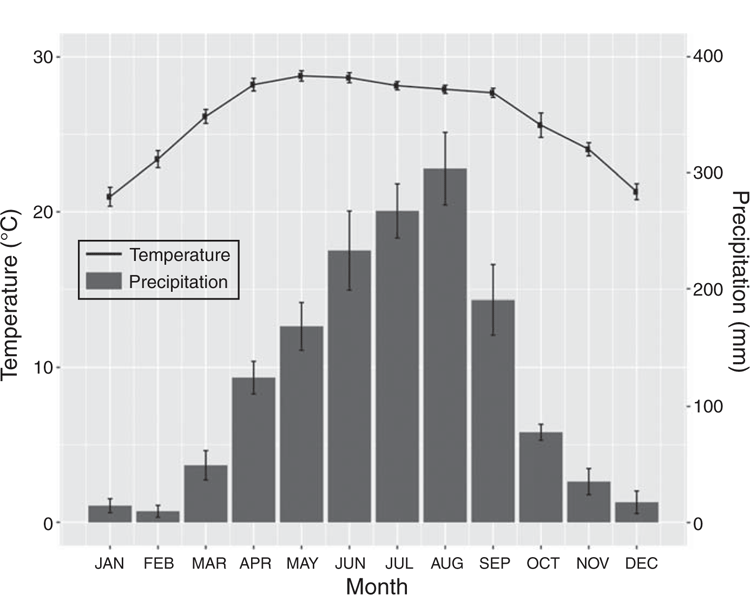Impact of forage introduction on cattle grazing practices and crop–livestock systems: a case study in an upland village in northern Laos
Khamphou Phouyyavong A B D , Shinsuke Tomita C and Satoshi Yokoyama AA Graduate School of Environmental Studies, Nagoya University, Environmental Studies Building, Furo-cho 510, Chikusa-ku, Nagoya 4648601, Japan.
B National Agriculture and Forestry Research Institute.
C Asian Satellite Campuses Institute, Nagoya University Furo-cho, Chikusa-ku, Nagoya, 464-8601, Japan.
D Corresponding author. Email: khamphou_p@hotmail.com
The Rangeland Journal 41(4) 323-334 https://doi.org/10.1071/RJ18102
Submitted: 1 November 2018 Accepted: 19 May 2019 Published: 10 August 2019
Journal Compilation © Australian Rangeland Society 2019 Open Access CC BY-NC-ND
Abstract
Lao smallholders are experiencing livestock grazing land constraints due to resettlement, increasing cattle numbers and commercial cash crop plantations. In this paper we describe changes in cattle grazing systems in an upland village in northern Laos, including the role of forage crops and their effects on cattle productivity. We interviewed 92 Hmong and Khmu households about their migration history, cattle grazing practices, cattle productivity and other livelihood activities. In addition, we measured the heart girths of 231 cattle. We found that the traditional free-range cattle grazing has diverged into three distinct systems incorporating fields fenced to different degrees. Although none of the three systems increased cattle body size, the forage pasture and swidden-farming system successfully increased the grazing capacity compared with other systems. Thus, this method appeared to be the most suitable for Hmong smallholders to manage crop and cattle production in the context of land constraints. Efforts should be made to examine how the newly implemented systems could attenuate villager livelihood and pre-emptively address the problems associated with degrading fallow land.
Additional keywords: crop–livestock system, forage, land use, rotational grazing, swidden farming.
Introduction
Smallholders in South-east Asia have long relied on the crop–livestock systems that integrate large ruminants, such as water buffalo and cattle, into subsistence-oriented crop farming (Devendra and Thomas 2002; Stür et al. 2002). Upland and lowland rice cultivation results in fallow natural vegetation that is used for extensive free-range feeding. Ruminants provide food protein and labour as draught animals, thus serving as a valuable asset that can act as a safety net for households (Vien et al. 2006). However, smallholders experience livestock feed and water deficiency during the dry season, and restrictions of free grazing in the wet season to avoid crop damage (Devendra and Thomas 2002; Phonvisay et al. 2016).
Regional socioeconomic changes (increasing population pressure on land use, shorter rotations, village resettlement, intensification of cropping, and livestock production) have necessitated fundamental changes to the historical crop–livestock systems (Roder 2001; Bouahom et al. 2004). Population increases in south-east Asia have led to shorter rotations for swidden agriculture and lower crop yields (Cramb et al. 2009). In an effort to enhance rural economic development and conserve natural resources, each household is now designated a set amount of arable land, thus limiting the cultivation area (Thongmanivong and Fujita 2006) and raising the population pressure (Jones et al. 2004). Economic development has also focussed on the introduction of cash crops (e.g. rubber-producing plants) to replace the traditional swidden farming. This shift shrinks the fallow vegetation area, and so decreases the amount of land suitable for cattle grazing (Takai and Sibounheuang 2010). Simultaneously, the region has seen an increase in demand for beef and a concurrent rise in cattle prices. As a result, cattle farming has become an increasingly important income source for smallholders (Huyen et al. 2010).
The inevitable land-use conflicts between large ruminant farming and cash crop cultivation are causing multiple issues in northern Laos. For example, the number of water buffalo has decreased (Takai and Sibounheuang 2010), and some buffalo owners have been forced to sell their livestock in order to avoid conflict with rubber plantation owners. This problem has exacerbated as the Lao government implemented land-use zoning to stabilise swidden farming, diminishing the fallow forests where water buffalo were allowed to graze freely. Indeed, smallholders in Laos had difficulties expanding their holdings because of these land constraints (Harding et al. 2007). It is difficult for the traditional Lao crop–livestock systems to co-exist with the shifting land uses occurring under modernisation.
One potential solution is to change cattle grazing systems through the introduction of forage crops that can be used for intensive grazing by livestock and reduce the amount of labour required to collect wild vegetation (Millar and Photakoun 2008). Changes in feed directly affect cattle health and bodyweight (Peters et al. 2001). On-farm fattening experiments conducted in northern Laos demonstrated that the farm-fattened cattle had growth rates eight times higher than the free-range cattle (Nampanya et al. 2014). Studies from Vietnam, where farmers are increasingly using forage crops, indicate that stall feeding and fattening techniques (cutting and carrying forage to penned livestock) have decreased the need for labour and have improved cattle productivity (Huyen et al. 2010; Stür et al. 2013).
Lao farmers employ a variety of pasture management practices, cattle raising methods, and seasonal combinations to ensure sufficient feed sources (Phonvisay 2013). However, few studies have examined variation in grazing systems across wet and dry seasons in relation to cattle productivity (Pravongviengkham 1998; Horne and Stür 1999; Nakatsuji 2010; Takai and Sibounheuang 2010; Shirai and Yokoyama 2014; Phonvisay et al. 2016). The aim of this study was to investigate the relationships between multiple grazing systems and cattle performance. First, we demonstrate how land constraints have altered cattle grazing systems, while accounting for seasonality; second, we evaluate the effect of forage crops on grazing systems and cattle productivity; and finally, based on our findings, we discuss a plausible future for crop–livestock systems for upland villages in northern Laos.
Research site
The study took place in Poung Pao village in the Phonxay district of Luang Prabang Province, ~80 km from the provincial capital. Although Poung Pao is not particularly remote, it does share other characteristics that are typical of upland villages in northern Laos: it is inhabited by Hmong and Khmu; the systems of farming include swidden farming and raising cattle; and migration and land constraints are issues for the village. These are common issues and, therefore, the conditions of this village can be seen as representative of upland villages in northern Laos (Fig. 1). The village is ~400 m above sea level, and is surrounded by mountains ranging from 1000 to 1400 m in elevation. Distinct wet and dry seasons occur from May to September and October to April respectively. Temperatures are higher in the wet season (the highest 41°C in May 2014) and lower in the dry season (the lowest 7°C in January 2014) (Fig. 2).
As of 2016, the village population was 826, with 132 households (Table 1). Most villagers belonged to the ethnic groups, Hmong and Khmu; these are the predominant ethnic groups in northern upland Laos (Epprecht et al. 2018). In 1997–1998, the number of Khmu households was 28, of which 16 moved away before 2003 (LSUAFRP 2003). This movement was confirmed by interviewing villagers, who stated that most Khmu households originally residing in the village had moved to central Laos. Of the 40 Khmu households surveyed in the study, all except five, immigrated to the village after 2000 (Table 2). Most current Hmong households moved during 2000–2004 from villages at relatively high elevations in the surrounding mountains (e.g. Pha Toop, Phou Soong Noy and Phou Ja Norm) (Fig. 1; Table 2). Villagers described a clear difference in migration patterns between the Hmong and Khmu groups. The Hmong immigrated as a village unit, whereas the Khmu did so in household units from multiple villages. Consequently, the Hmong group can be divided into three subgroups based on their village of origin from which the migration took place following the village merging program of the government to move people to closer to the road and other infrastructure facilities (LSUAFRP 2003).

|
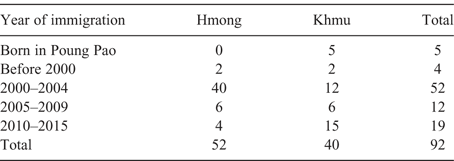
|
The Hmong and Khmu groups differ in their historical and current agricultural production methods, including the amount and type of livestock (Table 1). In their traditional villages before migration, generations of Hmong households grew high-value opium and owned cattle as their primary livestock. Cattle are preferred because of their resistance to cold and general tolerance of conditions at higher elevations. Moreover, the Hmong group live in regions with large grazing areas suitable for cattle. In contrast, the Khmu households tend to raise small livestock, such as poultry, because their lower-elevation villages contained less available grazing land (Schlemmer 2002). These historic settlement preferences (Sodarak 1999) have meant that the Hmong households have greater assets and are more often able to buy agricultural land and other necessities when settling in a new village (Table 1). The Land-Use Planning and Land Allocation program (LUPLA) was established in the early 1990s. Since then LUPLA has become one of the main elements of Laos’ land-use planning system. In its early form – often referred to as Land and Forest Allocation (LFA) – the program involved identification of the village boundaries and demarcation of the land to be conserved or regenerated as forest. The process became gradually more elaborate, involving the individual allocation of agricultural plots to village households and the zoning and mapping of the village land. The individual allocation of agricultural plots to village households meant a household has the land-use right of their agricultural land particularly for swidden farming (Lestrelin et al. 2012).
Government efforts to provide public service and infrastructure, have drastically changed the ethnic composition in Poung Pao. Populations in small villages have been encouraged to move to live near roads and basic infrastructure, e.g. through the 1997–1998 LUPLA program. These programs restricted the amount of arable land that villagers could use, limiting the ability of villagers to subsist off the mixed-farming livelihoods. Then, in 2000, 28 Khmu households in Poung Pao were allocated 150 ha land, which was divided into 133 plots, and the village authority received 437 ha. This is the land area that can be allocated to communal grazing areas, crop cultivation and swidden farming for any new households who claim agriculture land (LSUAFRP 2003). These changes led to an emigration of the Khmu households, who sold their allocated land to other villagers. Other Khmu households immigrated to Poung Pao, attracted by the promise of arable land, electricity, water, and other services. Simultaneously, the Opium Elimination Strategy prohibited the Hmong households from growing opium in the mountains, causing a move down to the village. Unsurprisingly, this increased population concentration resulted in disputes over land use (Jones et al. 2004). One notable consequence of these conflicts was increased cattle mortality, causing the Hmong households to move their cattle back to their original villages (LSUAFRP 2003). Hence, Hmong have more cattle than Khmu.
To address the issues related to cattle production, LSUAFRP, a joint rural development effort of the Lao government and Swedish International Development Agency (SIDA), introduced forage crops and cattle fattening techniques to Poung Pao during 2005–2006. The project freely distributed the seeds of several forage types (Ruzi grass, Napier grass, Stylo kegune and Mulato grass), educated villagers on cattle production and designated a fenced communal field to grow fodder. Cattle were allowed to graze in this field for several months after establishment of forage species. In addition, villagers were encouraged to fatten their cattle using the cut-and-carry system, where cattle were tethered in stalls within the settlement area and supplied with forage. Immediately after these methods were introduced, eight Hmong households started the cut-and-carry system, and this number increased to 23 by 2010, whereas other Hmong households employed free-grazing.
Methods
A mixed research methodology (including quantitative and qualitative methods) was used in this study. A focus group discussion with the village committee and cattle raiser group was conducted in May 2016 to obtain the viewpoints of the villagers with regard to their livelihoods. Semi-structured household interviews were then conducted in August 2016 with 92 out of the 132 households in the village were randomly selected households who are available in the villages at the time of survey and willingly to interview (Table 1). Households were interviewed regarding the composition of the family, migration history, sources of income, agricultural practices (swidden-farming, plantation of rubber, teak, cash crops), and land use. The income sources were grouped into four categories: cattle, other livestock, cash crops, and off-farm work. All cattle were of the indigenous yellow breed widely domesticated throughout East and South-east Asia (Namikawa et al. 2000; Wilson 2007) and genetically closest to the Vietnamese local cattle (Nomura et al. 2000). Other livestock included buffalos, pigs, poultry, and goats. The cash crops consisted of Job’s tears, sesame, maize, and rubber. The off-farm income involved hired labour for agricultural work, collecting non-timber forest products, construction, trading, and salaries or pensions from previous work. The swidden-farming practices, forage cultivation, and land acquisition methods such as inheritance, purchasing, rent, and allocation were also recorded.
In August 2017, data on the heart girths, age, sex and owner identity of 231 cattle were collected. The measurements were made for all cows in a household, if there were five or fewer cows in the household. If there were more than five cows in a household, we randomly selected only five and measured.
Household incomes in 2016 were compared with household incomes in 2003. The income data for 2003 included data for 17 households (five Hmong and 12 Khmu) (LSUAFRP 2003). One of the authors of the current study (K.P.) was also involved in the LSUAFRP project and was tasked with collecting data in the village. The data collection in 2003 and 2016 were done by the correspondent author using the same method.
In addition, we classified the cattle grazing systems prevalent in the village using three major components based on the previous studies conducted in Lao PDR (Table 3).
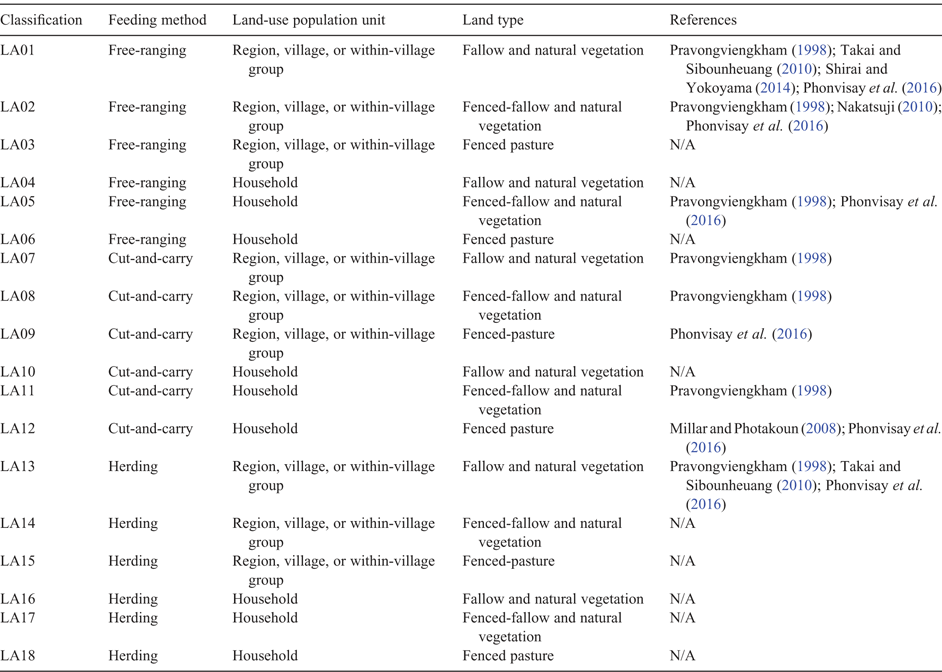
|
Free-range cattle are free-grazing and this was the most popular feeding type (Table 3). Previously, land-sharing has been relatively common between groups of villagers within a village, and between villages in a region (Pravongviengkham 1998; Takai and Sibounheuang 2010). More recently, some land-owning households have taken action to exclude other households from using their land, e.g. by fencing pasture land to exclude free-ranging cattle (Phonvisay et al. 2016). Additionally, villagers have enclosed land in order to: grow forage (Phonvisay et al. 2016); prevent cattle from feeding on cash crops (Takai and Sibounheuang 2010); and prevent thefts and wild-animal attacks on livestock (Pravongviengkham 1998; Nakatsuji 2010). Overall, we classified 18 different systems in Laos based on the feeding methods, land-use population unit, and land type, nine of which were novel (Table 3). These systems were then considered in the context of seasonality between the wet and dry seasons.
To test the influence of grazing systems on cattle productivity, we used analysis of variance (ANOVA) and a generalised linear model with t-tests. Heart girth is a predictor of liveweight and was, therefore, used as an index of cattle bodyweight (MacDonald et al. 2008; Lukuyu et al. 2016). All data were analysed in R 3.4.0
Results
Changes to household income structure
Compared with 2003, the total income of villagers was over two times greater in 2015 (Fig. 3), showing that the villagers are increasingly taking part in the market economy. This rise marks a shift from their engagement in diverse activities for livelihood to a greater reliance on cash-earning, specifically on cattle production and off-farm jobs.
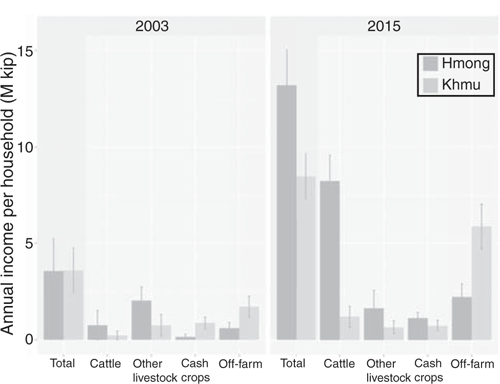
|
An income disparity grew between the Hmong and Khmu groups during this period. By 2015, Hmong households earned on average 1.8 times more than Khmu households, largely because Hmong households increased cattle production. The Khmu men worked more often as agricultural labourers and construction site workers in urban areas. Most Khmu households did not keep cattle. The income from cash crops did not change much during this period.
Differences in land use and number of cattle
The overall landholding size was significantly larger and land use more diversified in the Hmong households than in the Khmu households (Table 4). The average size of the land owned by the Hmong households (6.8 ha) was 2.8 times larger than that owned by the Khmu households (2.4 ha). Hmong households also held more land plots (on average 3.9 plots) than the Khmu households (on average 1.6 plots) (Table 5) The land area used for pasture, rubber, and teak plantations was significantly greater for Hmong households, but area used for swidden-farming was not significantly different between Hmong and Khmu households (Table 4). The Hmong households invested in a wider range of crops, whereas Khmu focussed almost entirely on swidden-farming (86% vs 42% for Hmong). In addition, over half of the Hmong households grew forage in at least one field, using 37% of their land on average, whereas most Khmu households did not grow forage at all (Table 5).
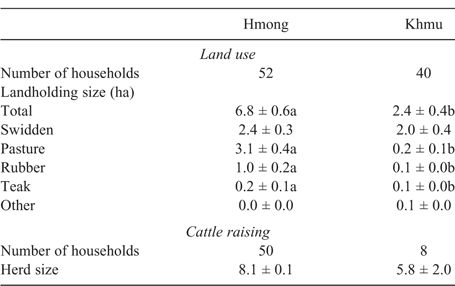
|

|
Most Hmong households (79%) raised cattle significantly more than the 20% of Khmu households that raised cattle (Table 4). Among the households that raised cattle, the herd size difference was not significant.
Both ethnic groups primarily acquired land through the village authority and purchases from other households at or before migration (Table 5). In addition, the Hmong households made post-migration land purchases for forage cultivation.
Cropping schedules of upland rice and forage crops
Upland rice was grown through swidden farming with a two-year fallow period, and with households normally owning three plots of upland rice fields and farmers rotating rice cultivation among the three plots (Fig. 4). Both Hmong and Khmu households conducted land preparation and seeding before the wet season and harvested after the wet season. Additionally, both groups fenced fields to protect upland rice from cattle grazing and destructive wildlife such as boars. Overall, the two ethnicities did not differ in their cropping schedules. During the fallow period, farmers did not weed the fields or apply fertilizer; cattle were allowed to graze freely in the fallow fields.
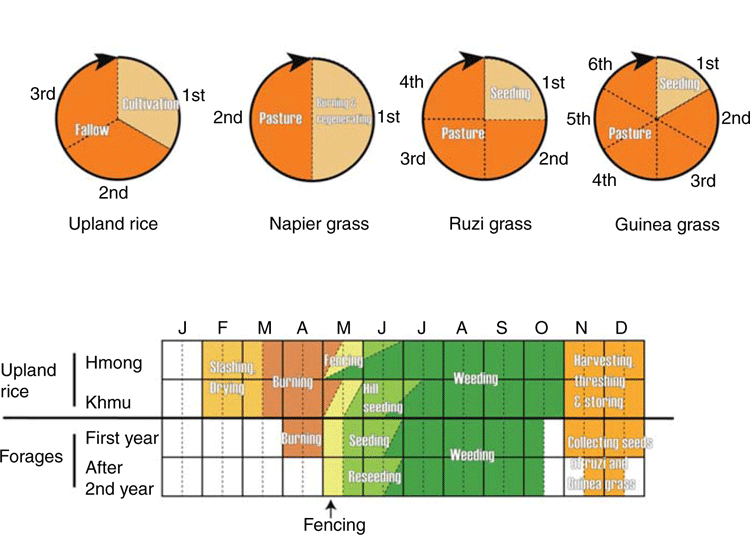
|
As of 2016, only Napier grass (Pennisetum purpureum), Ruzi grass (Brachiaria ruziziensis) and Guinea grass (Panicum maximum) were being grown as forage crops in the village. The Hmong households indicated that they had grown only Napier grass as a forage crop in their natal villages and were introduced to the other two forage crops through LSUAFRP.
Forage crops differed significantly in the years of pasture use, but not in the cropping calendars (Fig. 4). During the first year, all three forage crops were seeded after the commencement of the wet season, weeded for a few weeks, and grown to grazing-suitable pasture by November. The Ruzi and Guinea grasses can be used as pastures for three to five years (if properly managed with fence repair, reseeding, and weeding) after which farmers have to clean and regrow them. Because the Napier grass pastures must be burned for regeneration every two years, farmers need to replant Napier grass in areas where the Napier grass has died out. Although the Napier grass appeared to require more labour, villagers were accustomed to grow the Napier grass and found its management easy. The labour competition between upland rice and forage cultivation was higher during the wet season than during the dry season.
Types of cattle grazing systems
Five cattle grazing systems (Table 3) were identified during the last decade: system A, free-ranging in fallow and natural vegetation (LA01) in both seasons; system B, wet-season free-ranging in fenced-fallow (LA02) + dry-season LA01; system C, wet-season rotational grazing in fenced pasture + dry-season LA01; system D, rotational grazing in fenced pasture in both seasons; and system E, cut-and-carry (LA12) in both seasons (Fig. 5). System E was the stall-feeding method introduced by LSUAFRP. As of 2016, systems B, C, and D were still active. Of the feeding types reported in previous studies (Table 3), only free-range grazing was still in use. In addition, system C (rotational grazing) was becoming predominant. Some villagers still use the LSUAFRP-introduced communal land for cattle grazing.
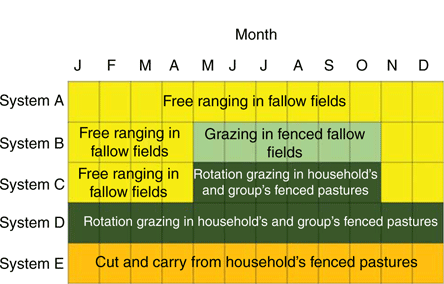
|
The national road to Luang Prabang separates Poung Pao into the north and south portions. The Hmong group uses the land to the north of the road, whereas the Khmu group uses the land to the south of the road. The group-managed fenced pastures were present in the Hmong natal villages (e.g. Pha Toop, Phou Soong Noy and Phou Ja Norm), located within a radius of ~4 km from Poung Pao. Only the households that originated from these villages were allowed to use the fenced pastures. Although we did not observe a clear relationship between household landholdings and forage crops, the Napier grass was more likely to be grown in the group-managed fenced pastures.
Previous studies in Laos did not mention rotational grazing. In the present study, we found that the Hmong group rotated their cattle among the household-managed and group-managed pastures during the wet season (system C) or across both the wet and dry seasons (system D). Villagers reported moving cattle to another pasture when the forage in one pasture had been completely grazed; the pasture fields are then fenced, and the forage regrown.
Although cattle were vaccinated in all grazing systems, villagers employing system B vaccinated only the cattle that showed signs of infection. More attention was paid to cattle health in systems C and D. According to the respondents, system D was the most labour-intensive (based on forage crop cultivation and yearly cattle grazing schedule), followed by systems C and B. The cattle numbers in each of the grazing systems B, C and D were 48, 224, and 181 respectively.
Most Hmong households employed systems C and D (Table 6). Only 15% of the total sampled households raised cattle using system B, and the majority of these were Khmu. The cattle density differed significantly between systems C and D (P < 0.05), but not between systems B and D. The significant difference was attributable to the increased amount of cattle raised under system C, despite a greater ratio of pasture size to the total landholding size in system D. However, the pasture size and number did not significantly differ between systems C and D. Furthermore, three systems (B, C and D) had similar herd size and cattle per labourer (Table 6). We also observed that the group-managed fenced pastures in natal villages of Hmong were able to considerably improve the rotational grazing capability. In systems C and D, even households with no pastures or only a single pasture could rotate their cattle among these group-managed pastures.
Changes in cattle grazing systems
The Hmong and Khmu groups differed significantly in the changes made to their cattle grazing systems. In 2000, most households either raised cattle using system A or had no cattle, regardless of their ethnicities (Fig. 6). Since 2004, the Hmong households increasingly began to use systems B, C, D and E; there was also a decrease in the use of system A and in the number of households not raising cattle. By 2016, systems A, B and E were used considerably less than systems C and D. Many households stopped using system E because it was easier to graze in a fenced area than use the cut-and-carry (system E). Another reason why respondents felt that the extra effort involved in cut-and-carry was not justified, was the difference in price when the cattle were sold. In contrast to the Hmong households, the proportion of no-cattle households among the Khmu households remained consistent during 2000–2016. However, the use of system A declined among the Khmu households from 2006 until it was completely replaced with system B or C by 2016. The reason for the decline in use of system A was because the land area became more limited as the area occupied by rubber and other cash crops increased in the village. Therefore, villagers assigned and fenced-fallow and fenced pastured for cattle grazing. Of the studied households, two households stopped cattle production entirely because all cattle had died or were sold.
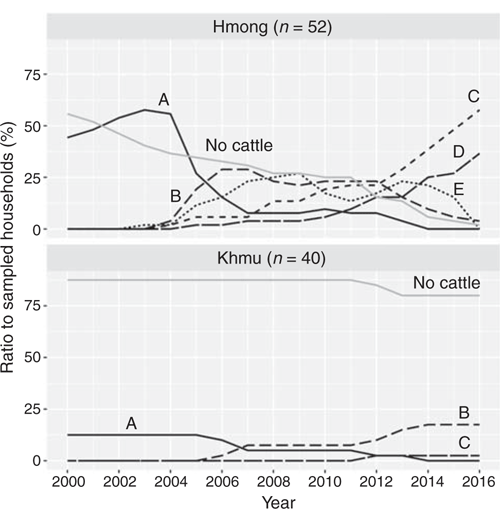
|
In summary, the Hmong households drastically changed their production strategy over the 17-year analysis period, experimenting with several systems before selecting C or D. Furthermore, some households with no cattle also participated in these two systems because they used to have cattle before 2016. In contrast, the Khmu households showed an overall simpler trend of shifting from system A to system B (Fig. 6) because Khmu households engaged in swidden-farming and have no forage fields.
Differences in cattle growth among grazing systems
As expected, there was a difference in the growth rate of male and female cattle, with males growing faster than females by age four (Fig. 7). Beginning at age three, female heart girth remained consistent at ~1.4 m as they reached maturity. Sex differences among older cattle could not be compared because the village had no males older than five years; the bulls were typically sold when they were approximately four years old, whereas the cows were kept until they were 12 years old.
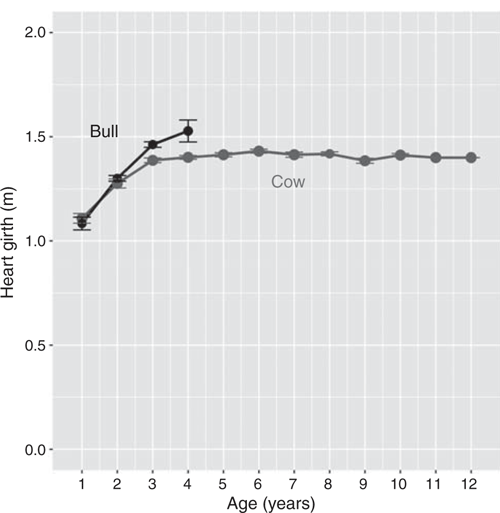
|
Heart girth among cattle aged one to four was significantly related to their age, sex, and the ethnicity of the households that owned the cattle, but not to the grazing system or socioeconomic variables, implying the rejection of our hypothesis, which proposed that different grazing systems may lead to differences in cattle productivity (Table 7). The Khmu households tended to have cattle with heart girths larger than those owned by the Hmong households. Although the pasture size had no significant effect on cattle growth, the positive effect of number of pasture plots trended towards significance (P = 0.0801); this may be because Khmu cattle were fewer in number and they were free grazing in the fallow-fenced area, where natural grass was grown, whereas Hmong households have more cattle and grazed in assigned and fenced areas.

|
Discussion
Responses to land constraints under rising beef prices
The Hmong and Khmu groups differed noticeably in their responses to rising beef prices, which increased from 34 139 Lao kip/kg in January 2010 to 66 256 Lao kip/kg in January 2015 (Lao Statistics Bureau 2011, 2016). The Hmong households diversified their livelihood portfolios, building on their cattle production and other forms of commercial farming (e.g. rubber plantations) to supplement swidden farming of upland rice. In contrast, the Khmu households focussed on subsistence-oriented swidden farming and off-farm work, without increasing cattle production. In the villages of origin, the Khmu households generally had fewer assets and earned less than Hmong households.
In conjunction with their diversified portfolio, the Hmong households were more likely to purchase extra land for forage cultivation. The households of both ethnicities received identical-sized plots upon arrival in the village, but the Hmong group purchased land from the Khmu group after immigration. As a result, the landholding area was significantly larger among the Hmong households than the Khmu.
However, neither ethnic group possess enough land for maintaining their livelihood, as the village authority limits the total area that can be officially allocated to them. Villagers stated in their interviews that the field rotation for upland rice cultivation occurs in a three-year cycle (two-year fallow period followed by rice cultivation). However, neither the Hmong nor the Khmu households had sufficient land (the Hmong had an average of 6.8 ha of land in an average of 3.9 plots; the Khmu had an average of 2.4 ha of land in an average of 1.6 plots) for swidden farming, unless the communal or unallocated land is also used for cattle grazing. In addition, the village does not contain enough pastures for effective rotational cattle grazing; for instance, many Hmong households own less than two plots for forage cultivation in Poung Pao and must supplement with communal lands in their natal villages where they cultivated forage. A clear negative consequence of this situation is the expansion to unauthorised land, such as conservation forests, widely observed in upland villages in northern Laos (Pravongviengkham 2004).
The distinctly different responses of the Hmong and Khmu groups were more attributable to their livelihood history than to ethnicity. The Khmu households did not have communal lands for rotational grazing or saved capital from lucrative agricultural businesses (e.g. opium cultivation and cattle herding reported in LSUAFRP 2003), as the Hmong households did in their natal villages. Thus, the Khmu have few options besides selling their land and focusing on off-farm work to earn their livelihoods.
Changes to cattle grazing systems
The principal driving forces of changes in crop–livestock systems are natural resources, population pressure, urbanisation, and market opportunities. These driving forces have also been reported in studies in West Africa (Fernández-Rivera et al. 2004). For example, in the Harar Highlands of Ethiopia, as more land is used to grow cash crops, farmers lease out or sell animals instead of overstocking animals on the smaller areas of land available for grazing (Kassa et al. 2002). In Laos, the diminishing available land and raising opportunity to export beef to Vietnam and China are likely a major impetus for the observed changes in cattle grazing systems. As the population of Poung Pao rose sharply during 2000–2004, a corresponding limitation of the natural grazing area negatively affected rice production as free-ranging livestock use the upland fields as grazing area (Takai and Sibounheuang 2010). As confining the cattle was the easiest way of preventing crop damage, the Hmong households drastically decreased their use of free-range grazing beginning in 2004 and switching to the fenced-in fallow fields during the wet season. Further, to mitigate over-grazing under confinement, the Hmong farmers also included forage crops and rotational grazing. The latter method reducing the grazing pressure and necessary pasture size compared with continuous grazing (Hart et al. 1993). However, the pastures included in rotational grazing were located in the Hmong natal villages, and the long travel distance and extra effort could outweigh any positive effects on weight gain for the cattle (Hart et al. 1993).
The swidden farming system (in which the land is ‘slashed and burned’ and then primarily planted with rice followed by upland rice fallow) provides a significant grazing area during dry season, which allows the villagers to feed cattle throughout the year. During the dry season, the free-range grazing resulted in a higher number of cattle, whereas the rotational grazing increased the ratio of the pasture size to the total landholding size. The two systems did not differ in pasture size or number. These results suggest that fallow fields hold larger numbers of cattle. Contrary to expectation (e.g. Horne 1998), growing forage in the dry season did not increase the herd size unless farmers made hay or silage. Indeed, compared with fallow vegetation, the forage crops improved fodder quality as well as quantity in the wet season, but did not improve fodder uptake during the dry season. This finding was a part of the reason why the cut-and-carry system had fallen out of favour by 2016, and had largely been replaced with rotational grazing. Another factor that contributed to this change was labour intensity. Villagers found that the cut-and-carry system required more labour than free grazing. This contradicts previous suggestions that the cut-and-carry system was relatively less labour-intensive for livestock (such as pigs, cattle and goats) that needed supplementary fodder in the dry season especially in lowland villages (Millar and Photakoun 2008; Stür et al. 2013).
Effects of forage crops and rotational grazing on cattle productivity
Differences in grazing systems (e.g. pasture size and number) did not affect the cattle body size, with only age and sex being significant factors. This result implies that the pastures and fallow vegetation are equally effective in maintaining cattle; however, there is potential to increase the cattle performance if the cattle are properly fed, e.g. by intensive fattening. Therefore, forage crops should contribute to maintaining, and possibly increasing, cattle body size, even if the fallow grazing area decreases. In addition, the lack of a relationship between pasture plot number and body size could be ascribed to the intervening effects from the increased travel distance to pastures and water (Hart et al. 1993). Monitoring cattle grazing behaviour via GPS might, therefore, contribute to improving grazing systems (Turner et al. 2000; Shirai and Yokoyama 2014).
Cattle, particularly bulls, in the study village have the potential for weight increase. The domestic yellow bulls and cows in Laos can weigh up to 600 and 400 kg respectively (Wilson 2007). Further, the liveweight of a bull at age four is ~200 kg, whereas a mature cow weighs only 180 kg (MacDonald et al. 2008). The use of the cut-and-carry fattening methods also warrant more consideration in terms of increasing cattle productivity (Nampanya et al. 2014); in northern Vietnam, the same breed of cattle supplemented with cut-and-carry forage grew to 220–230 kg at the age of four years (Huyen et al. 2011). However, market push, government support and a cost–benefit analysis that considers villager descriptions of increased labour must be performed before expending more effort on encouraging the cut-and-carry system or maintaining free-grazing (Phonvisay 2013).
Overall, the swidden farming-based grazing resulted in the highest cattle holding, an outcome that seems linked to the increased labour intensity of maintaining rotational grazing all year long compared with grazing on fallow fields with larger areas. Thus, even if the rising beef prices appear to offset productivity decreases, increased labour requirements and decreased soil fertility were observed under rotational grazing because this system in the fenced pasture plots puts more pressure on soil as there is a shorter duration for soil nutrient recovery (Roder et al. 1995). However, if rotational grazing is allowed in assigned areas, the soil would receive nutrients in the form of manure. This might diminish the actual economic return from cattle raising efforts because the poor soil leads to relatively less forage biomass, which in turn affects cattle performance. Moreover, the labour shortages per household do not seem to be an issue in Poung Pao, in contrast with other studies concerning cattle production in northern Vietnam (Huyen et al. 2010). However, more research on the exact time allocation of household labour on cattle production would provide further insight into the division of labour and existence of potential shortages.
Changing crop–livestock systems
The different forms of crop–livestock systems are decreasing or increasing in popularity in the study village as land quotas, an increasing population, and changing economics force households to alter their land-allocation strategies and use unallocated lands. In particular, the introduction of cash crops has reduced the land available for subsistence-based swidden farming of rice and cattle grazing. Of the five systems developed to use the remaining land, the systems that incorporate forage crops (i.e. system C) have become more popular because rotational grazing is employed in forage pastures only during the wet season, with the supplementation of free-range grazing on fallow vegetation in the post-harvest dry season. This method successfully maintains both upland rice and cattle production, while increasing the cattle holding capacity of the village. In contrast, the systems dependent on grazing in fenced fields (systems B and D) are becoming less popular. This is probably due to increasing tensions between rice and cattle production during the wet season. Specifically, the emphasis of system B on grazing in fallow fields limits cattle production, as the land is already being used for rice cultivation. Likewise, the focus of system D on the year-long pasture grazing prevents that land from being converted to rice fields. As seen in the Khmu households, the land constraints and rising cattle prices can limit cattle production among smallholders, whereas the upland rice production excludes the land from being used for cattle grazing and vice versa. In systems where the cattle graze only on fallow vegetation, a shortened fallow period that degrades the fallow fields also limits cattle productivity, increasing the difficulty of maintaining such systems.
Crop–livestock systems have long provided food security and have a continued potential to mitigate the adverse effects of the changing market conditions in northern Laos (Nie et al. 2016). Declines in such systems to simply favour intensifying cattle production could increase smallholder vulnerability to a fluctuating market. Furthermore, animal wastes from intensive industrial livestock degrade environment quality (Naylor et al. 2005). Thus, future studies should expand their focus from profitability to include the investigations of food security and household safety nets. In addition, the efficiency of resource use (e.g. circulation of raw materials) across various crop–livestock systems should be compared for a better evaluation of livelihood sustainability.
Conclusions
The traditional free-range, swidden-based grazing system in Poung Pao village of northern Laos has evolved under increasing pressure from land constraints and changing market economy. The three systems that have emerged include: (1) grazing fenced fallow vegetation during the wet season; (2) rotational grazing in pastures during the wet season; and (3) rotational grazing in pastures during both dry and wet seasons. None of the systems increased cattle body size but the system that integrated pastures and swidden-farming successfully increased the grazing capacity, and balancing crop and cattle production in the context of land constraints. Therefore, the rising financial costs of cattle production prevented households that did not have savings from raising cattle, leading to a wide disparity in annual income and landholding size.
Conflicts of interest
The authors declare no conflicts of interest.
Acknowledgements
The authors are thankful for the support and information provided by the Poung Pao residents, as well as the staff of the District Agriculture and Forestry offices, during the field survey. They are also thankful to the anonymous reviewers for their valuable suggestions and comments on the paper. This work was supported by the Transnational Doctoral Program for Leading Professionals in Asian Countries in Nagoya University and a KAKENHI grant from the Japan Society for the Promotion of Science (grant number 16H03115).
References
Bouahom, B., Douangsavanh, L., and Rigg, J. (2004). Building sustainable livelihoods in Laos: untangling farm from non-farm, progress from distress. Geoforum 35, 607–619.| Building sustainable livelihoods in Laos: untangling farm from non-farm, progress from distress.Crossref | GoogleScholarGoogle Scholar |
Cramb, R. A., Pierce Colfer, C. J., Dressler, W., Laungaramsri, P., Le, Q. T., Mulyoutami, E., Peluso, N. L., and Wadley, R. L. (2009). Swidden transformations and rural livelihoods in southeast Asia. Human Ecology 37, 323–346.
| Swidden transformations and rural livelihoods in southeast Asia.Crossref | GoogleScholarGoogle Scholar |
Devendra, C., and Thomas, D. (2002). Crop–animal interactions in mixed farming systems in Asia. Agricultural Systems 71, 27–40.
| Crop–animal interactions in mixed farming systems in Asia.Crossref | GoogleScholarGoogle Scholar |
Epprecht, M., Nicholas, B., Ehrensperger, A., Nagasawa, H., Lu, J., Studer, D., Vollmar, P., Bernhard, R., and Sisoulath, V. (2018). ‘Socio-Economic Atlas of the Lao PDR. Patterns and Trends from 2005 to 2015.’ (Centre for Development and Environment, University of Bern, and Lao Statistic Bureau: Lao PDR, with Bern Open Publishing.)
Fernández-Rivera, S., Okike, I., Manyong, V., Williams, T. O., Kruska, R. L., and Tarawli, S. A. (2004). Classification and description of the major farming systems incorporating ruminant livestock in West Africa. In: ‘Proceeding of the Sustainable Crop–Livestock Production for Improved Livelihoods and Natural Resource Management in West Africa’. IITA, Ibadan, Nigeria, 19–22 November 2001. (Eds T. O. Williams, S. A. Tarawali, P. H. Y. Hiernaux and S. Fernández-Rivera.) pp. 89–122. (ILRI: Nairobi, Kenya.)
Harding, M., Quirke, D., and Warner, R. (2007). Cattle and buffalo in Cambodia and Laos: the economic and policy environment for smallholders. Project final report. PLIA/2006/012 – Part 2. (ACIAR: Canberra, ACT.) Available at https://www.aciar.gov.au/node/9216 (accessed 1 April 2019).
Hart, R. H., Bissio, J., Samuel, M. J., and Waggoner, J. W. (1993). Grazing systems, pasture size, and cattle grazing behavior, distribution and gains. Journal of Range Management 46, 81–87.
| Grazing systems, pasture size, and cattle grazing behavior, distribution and gains.Crossref | GoogleScholarGoogle Scholar |
Horne, P. (1998). Securing the livelihoods of farmers in upland areas of Lao PDR: the role of livestock and opportunities for forage development. In: ‘Upland Farming Systems in the Lao PDR: Problems and Opportunities for Livestock’. (Eds E.C. Chapman, B. Bouahom and P. K. Hansen.) pp. 156–162. (ACIAR: Canberra, ACT.)
Horne, P. M., and Stür, W. W. (1999). Developing forage technologies with smallholder farmers: how to select the best varieties to offer farmers in Southeast Asia. ACIAR Monograph 62. 80 p. Available at: https://cgspace.cgiar.org/bitstream/handle/10568/53974/rfd_series_how_to_select.pdf?sequence=1 (accessed 22 June 2019).
Huyen, T., Herold, P., and Zárate, A. V. (2010). Farm types for beef production and their economic success in a mountainous province of northern Vietnam. Agricultural Systems 103, 137–145.
| Farm types for beef production and their economic success in a mountainous province of northern Vietnam.Crossref | GoogleScholarGoogle Scholar |
Huyen, L. T. T., Herold, P., Markemann, A., and Zárate, A. V. (2011). Resource use, cattle performance and output patterns on different farm types in a mountainous province of northern Vietnam. Animal Production Science 51, 650–661.
| Resource use, cattle performance and output patterns on different farm types in a mountainous province of northern Vietnam.Crossref | GoogleScholarGoogle Scholar |
Jones, P., Sysomvang, S., Amphaychith, H., and Bounthabandith, S. (2004). Village land use and livelihoods. Issues associated with shifting cultivation, village relocation and village merging programmes in the uplands of Phonxay District, Luangprabang Province. In: ‘NAFRI Workshop Proceedings. Shifting Cultivation and Poverty Eradication in the Uplands of Lao PDR’. pp. 149–159. (National Agriculture and Forestry Research Institute: Vientiane, Lao PDR.)
Kassa, H., Blake, R. W., and Nicholson, C. F. (2002). The crop–livestock subsystem and livelihood dynamics in the Harar Highlands of Ethiopia. In: ‘Proceedings of Responding to the Increasing Global Demand for Animal Products. International Conference organised by the British Society of Animal Production’. pp. 74–75. (British Society of Animal Production: Penicuik, UK.) Available at http://digitalcommons.calpoly.edu/agb_fac/79/ (accessed 22 June 2019).
Lao Statistics Bureau (2011). ‘Statistical Year Book 2010.’ (Ministry of Planning and Investment: Vientiane, Lao PDR.)
Lao Statistics Bureau (2016). ‘Statistical Year Book 2015.’ (Ministry of Planning and Investment: Vientiane, Lao PDR.)
Lestrelin, G., Castella, J. C., and Bourgoin, J. (2012). Territorialising sustainable development: the politics of land-use planning in Laos. Journal of Contemporary Asia 42, 581–602.
| Territorialising sustainable development: the politics of land-use planning in Laos.Crossref | GoogleScholarGoogle Scholar |
LSUAFRP (Lao-Swedish Upland Agriculture and Forestry Research Program) (2003). Field report on land use planning and land management activities in Phonsay District. Field report no. 03/12. National Agriculture and Forestry Research Institute, Vientiane, Lao PDR.
Lukuyu, M. N., Gibson, J. P., Savage, D. B., Duncan, A. J., Mujibi, F. D. N., and Okeyo, A. M. (2016). Use of body linear measurements to estimate liveweight of crossbred dairy cattle in smallholder farms in Kenya. SpringerPlus 5, 63.
| Use of body linear measurements to estimate liveweight of crossbred dairy cattle in smallholder farms in Kenya.Crossref | GoogleScholarGoogle Scholar | 26839756PubMed |
MacDonald, T., Windsor, P., Rast, L., and Bush, R. (2008). Using girth measurements to estimate the live weight of cattle. Available at: https://mekonglivestock.files.wordpress.com/2013/10/macdonald-2010-weigh-tape.pdf (accessed 1 April 2019).
Millar, J., and Photakoun, V. (2008). Livestock development and poverty alleviation: revolution or evolution for upland livelihoods in Lao PDR? International Journal of Agricultural Sustainability 6, 89–102.
| Livestock development and poverty alleviation: revolution or evolution for upland livelihoods in Lao PDR?Crossref | GoogleScholarGoogle Scholar |
Nakatsuji, S. (2010). Rural development, migrations and livelihood change in Northern Laos: comparing livelihood in a lowland village with that in a highland village in Xiangngeun District, Luang Phabang Province. Geographical Science 65, 26–49.
Namikawa, T., Yamagata, T., Nannen, H., Kurosawa, Y., Nishibori, M., Yamamoto, Y., Bouahom, B., Vannasouk, T., Sengdara, B., Keonouchanh, S., Phouthavong, K., Novaha, S., and Phannavong, B. (2000). Coat-color variations and body-measurements of the native cattle in Laos. Report of the Society for Research on Native Livestock 18, 37–43.
Nampanya, S., Khounsy, S., Rast, L., Young, J. R., Bush, R. D., and Windsor, P. A. (2014). Progressing smallholder large-ruminant productivity to reduce rural poverty and address food security in upland northern Lao PDR. Animal Production Science 54, 899–907.
| Progressing smallholder large-ruminant productivity to reduce rural poverty and address food security in upland northern Lao PDR.Crossref | GoogleScholarGoogle Scholar |
Naylor, R., Steinfeld, H., Falcon, W., Galloway, J., Smil, V., Bradford, E., Alder, J., and Mooney, H. (2005). Losing the links between livestock and land. Science 310, 1621–1622.
| Losing the links between livestock and land.Crossref | GoogleScholarGoogle Scholar | 16339432PubMed |
Nie, Z., McLean, T., Clough, A., Tocker, J., Christy, B., Harris, R., Riffkin, P., Clark, S., and McCaskill, M. (2016). Benefits, challenges and opportunities of integrated crop–livestock systems and their potential application in the high rainfall zone of southern Australia: a review. Agriculture, Ecosystems & Environment 235, 17–31.
| Benefits, challenges and opportunities of integrated crop–livestock systems and their potential application in the high rainfall zone of southern Australia: a review.Crossref | GoogleScholarGoogle Scholar |
Nomura, K., Takahashi, Y., Amano, T., Tanaka, K., Yamagata, T., Mannen, H., Kurosawa, Y., Nishibori, M., Yamamoto, Y., Namikawa, T., Vannasouk, T., Sengdara, B., Phouthavong, K., Novaha, S., Phannavong, B., and Bouahom, B. (2000). Constitution of genes controlling blood protein types of Laos native cattle and their phylogenetic study. Report of the Society for Research on Native Livestock 18, 45–57.
Peters, M., Horne, P., Schmidt, A., Holmann, F., Kerridge, P. C., Tarawali, S. A., Schultze-Kraft, R., Lascano, C. E., Argel, P., Stür, W., Fujisaka, S., Müller-Sämann, K., and Wortmann, C. (2001). The role of forages in reducing poverty and degradation of natural resources in tropical production systems. Agricultural Research and Extension Network. Network paper no. 117. Overseas Development Institute, London.
Phonvisay, A. (2013). Livestock and livelihoods: trajectories in the production and marketing of large ruminants in the uplands of Northern Laos. PhD thesis, School of Agriculture and Food Sciences, The University of Queensland, Qld, Australia. Available at: https://espace.library.uq.edu.au/view/UQ:297467 (accessed 1 April 2019).
Phonvisay, A., Vanhnalath, B., Sinavong, P. (2016). Pro-poor policy analysis on cattle productivities and industry in Lao PDR. Study report for program GCP/RAS/273IFA & TCP/RAS/3405.
Pravongviengkham, P. P. (1998). Swidden-based farm economies in northern Laos: diversity, constraints and opportunities for livestock. In: ‘Upland Farming Systems in the Lao PDR: Problems and Opportunities for Livestock’. (Eds E. C. Chapman, B. Bouahom and P. K. Hansen.) pp. 89–102. (ACIAR: Canberra, ACT.)
Pravongviengkham, P. P. (2004). Upland natural resources management strategies and policy in the Lao PDR. In: ‘Ecological Destruction, Health and Development. Advancing Asian Paradigms’. pp. 481–501. (Kyoto University Press: Kyoto, Japan.)
Roder, W. R. (2001). ‘Slash-and-burn Rice System in the Hills of Northern Lao PDR: Description, Challenges, and Opportunities.’ (International Rice Research Institute: Los Bãnos, The Philippines.)
Roder, W., Phengchanh, S., and Keoboulapha, B. (1995). Relationships between soil, fallow period, weeds and rice yield in slash-and-burn systems of Laos. Plant and Soil 176, 27–36.
| Relationships between soil, fallow period, weeds and rice yield in slash-and-burn systems of Laos.Crossref | GoogleScholarGoogle Scholar |
Schlemmer, G. (2002). ‘Community Livelihoods Analysis.’ (IUCN/MAF: Vientiane, Lao PDR.)
Shirai, M., and Yokoyama, S. (2014). Grazing behavior and local management of cattle and buffaloes in rural Laos. In: ‘Integrated Studies of Social and Natural Environmental Transition in Laos’. (Eds S. Yokoyama, K. Okamoto, C. Takenaka and I. Hirota.) pp. 63–84. (Springer: Tokyo, Japan.)
Sodarak, H. (1999). Shifting cultivation practices by Hmong, Khamu and Lao ethnic categories in the Nam Nane Watershed, Nane District, Luang Prabang Province, Lao PDR. Master’s thesis, Swedish University of Agricultural Sciences, Uppsala, Sweden.
Stür, W. W., Horne, P. M., Gabunada, F. A., Phengsavanh, P., and Kerridge, P. C. (2002). Forage options for smallholder crop–animal systems in Southeast Asia: Working with farmers to find solutions. Agricultural Systems 71, 75–98.
| Forage options for smallholder crop–animal systems in Southeast Asia: Working with farmers to find solutions.Crossref | GoogleScholarGoogle Scholar |
Stür, W., Khanh, T. T., and Duncan, A. (2013). Transformation of smallholder beef cattle production in Vietnam. International Journal of Agricultural Sustainability 11, 363–381.
| Transformation of smallholder beef cattle production in Vietnam.Crossref | GoogleScholarGoogle Scholar |
Takai, Y., and Sibounheuang, T. (2010). Conflict between water buffalo and market-oriented agriculture: a case study from northern Laos. South Asian Studies 47, 451–477.
Thongmanivong, S., and Fujita, Y. (2006). Recent land use and livelihood transitions in Northern Laos. Mountain Research and Development 26, 237–244.
| Recent land use and livelihood transitions in Northern Laos.Crossref | GoogleScholarGoogle Scholar |
Turner, L. W., Udal, M. C., Larson, B. T., and Shearer, S. A. (2000). Monitoring cattle behavior and pasture use with GPS and GIS. Canadian Journal of Animal Science 80, 405–413.
| Monitoring cattle behavior and pasture use with GPS and GIS.Crossref | GoogleScholarGoogle Scholar |
Vien, T. D., Leisz, S. J., Lam, N. T., and Rambo, A. T. (2006). Using traditional swidden agriculture to enhance rural livelihoods in Vietnam’s uplands. Mountain Research and Development 26, 192–196.
| Using traditional swidden agriculture to enhance rural livelihoods in Vietnam’s uplands.Crossref | GoogleScholarGoogle Scholar |
Wilson, R. T. (2007). Status and prospects for livestock production in the Lao People’s Democratic Republic. Tropical Animal Health and Production 39, 443–452.
| Status and prospects for livestock production in the Lao People’s Democratic Republic.Crossref | GoogleScholarGoogle Scholar | 17966276PubMed |



